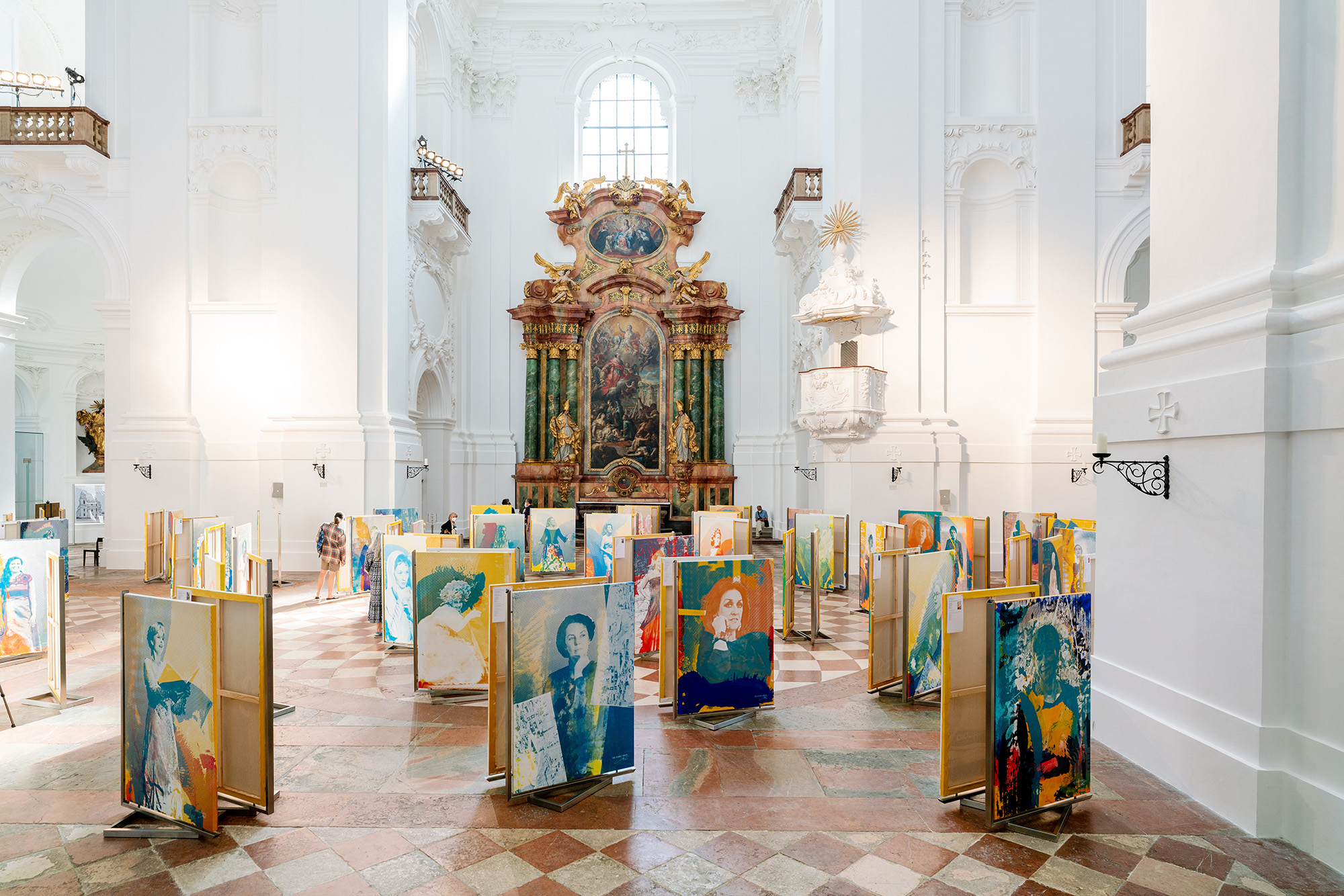100 FEMALE VOICES
Martina Stock’s audio-visual project 100 FEMALE VOICES exhibited in the Kollegienkirche presents female cultural history in images and sound. Martina Stock shows an artistic genealogy of women from the past 100 years of the Salzburg Festival who have worked in opera, drama, dance, stage design, directing, composition, literature, etc. The project serves to promote gender equality. By means of portraits of outstanding female artists on unique silkscreen prints and musical interpretation, a history is constructed that did not exist before in this form. Martina Stock, whose principal media are the acoustic harp- refined with electronics, beats and sound surfaces- and the unique silkscreen on canvas, recounts history by means of selected personalities dissolved into individual highlights of a particular performance, role and presentation. The number 100 has a symbolic meaning, as it is about each of the 100 selected personalities of the past 100 years, as well as the interdisciplinary approach and totality of female artistic creation. Visitors are guided through the multimedia exhibition which unfolds itself in various layers and loops, string sounds, and the painterly layered work. Martina Stock, who paints with a sieve, creates a rich web of relationships that oscillates between the past and the present, bringing space and time together in a multi-sensorial way. The works, positioned back to back to form an extensive installation in the baroque nave, convey a strong alliance of women.
This audiovisual installation, conceived as an integrated work of art, does not seek to define a female aesthetic, but instead to create a multifaceted narrative with numerous fractures and tensions that uses portraits to depict, reflect, and revise time and ages. Recounting history from a different perspective also means asking questions. How, for instance, does gendered chronology relate to the dominant cultural narrative that was shaped by male protagonists? Should a history that focuses on female art-making define itself by deviating from an established narrative? What is the lasting impact of both emancipatory movements and strategies of self-assertion in women's art? What can we learn from history? Do we need to correct and change it in retrospect? Martina Stock‘s 100 FEMALE VOICES is first and foremost a homage to female artistic creation. It casts female artists in a golden light of the baroque central nave of the Kollegienkirche, the first venue of the Salzburg Festival in 1922 and patron god of the arts and the Frauenkirche, a light that rises in many reflections to an apotheosis that transcends ages.
Text: Angela Stief, Chief Curator, ALBERTINA MODERN, Vienna

100 Dazzling Women in Salzburg's Church of Light
One hundred life-size portraits of renowned female artists commemorating one hundred years of Festival history are exhibited by Martina Stock in Salzburg's Kollegienkirche.
Why in a church, you might ask? Is this a church service? Perhaps. When one strolls through the exhibition of the images, which are positioned in pairs, seemingly at random, one senses energy comparable to the beginning of a performance or a pilgrimage. One hundred women from one hundred years assembled in Salzburg's Frauenkirche in the “here and now“ - in the midst of them is Mary, depicted on the high altar, as their patroness.
Martina Stock's images glow in the colors of the rainbow and the actual photos of the women recede into the background. Fulfilled, enthusiastic individuals shine from within like saints. The artist has made this glow visible to all of us. The Kollegienkirche in its glittering, divine whiteness provides the indispensable canvas for this.
The Kollegienkirche in Salzburg is renowned for its art. With his architecture, Fischer von Erlach's created one of the most important sacred buildings of the Baroque era. With the world premiere of Hugo von Hoffmannsthal‘s "Das Salzburger große Welttheater", the Kollegienkirche became the first performance venue of the Festival for the play. Today the university parish cultivates a lively exchange among numerous young artists. A stellar example of this our dialogue with Martina Stock.
The procession of women from 100 years fits well into the concept of this church, in which the architect wanted to represent the "Heavenly Jerusalem". Here neither gender nor origin plays a role. It is only the passion of people who strive for truthfulness that counts.
Christian Wallisch-Breitsching
Kollegienkirche Salzburg

